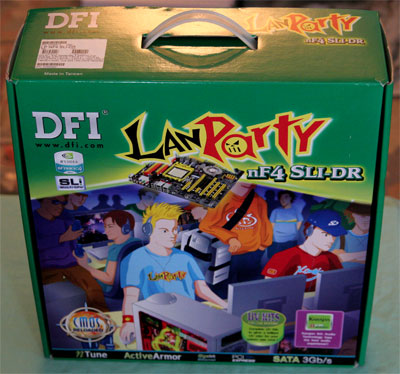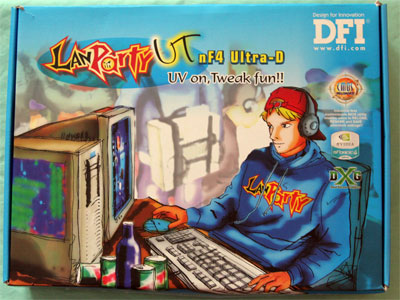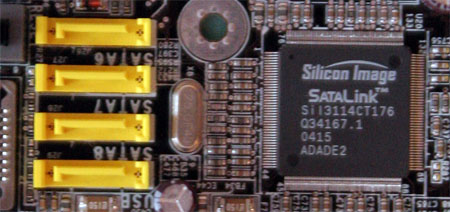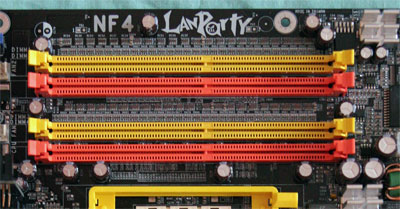DFI nForce4: SLI and Ultra for Mad Overclockers
by Wesley Fink on February 5, 2005 9:30 AM EST- Posted in
- Motherboards
Basic Features: DFI nForce4
DFI uses the same PCB for all nForce4 models. This assures that the overclocking capabilities of all the nForce4 boards are the same. In fact, all boards use the same BIOS. The 3 DFI nForce4 models are:- LANParty nF4 SLI-DR
- LANParty UT nF4 SLI-D
- LANParty UT nF4 Ultra-D
Models with the SLI name feature the nVidia nForce4 SLI chipset, while those with Ultra use the nF4 Ultra chipset. All boards feature dual PCIe slots, and the "R" in the SLI-DR adds Silicon Image 3114 4-drive SATA RAID. The two LANParty UT models are identical except one uses the SLI Chipset and the other uses nF4 Ultra.

We tested production models of the top and bottom of the DFI nForce4 lineup, and we can report that performance of these two models was exactly the same in all our benchmarks. Your choice, therefore, should be based on the SLI/Ultra choice and other features. In addition, those who are willing to mod a chip can make a minor change to the $140 Ultra-D board and convert it into an SLI chipset with SLI performance identical to the top line SLI boards. Details on this mod are available at Morphing nForce4 Ultra into nForce4 SLI.
| Specification | DFI LANParty nF4 SLI-DR | DFI LANParty UT nF4 Ultra-D |
| CPU Interface | Socket 939 Athlon 64 | |
| Chipset | nForce4 SLI (single chip) | nForce4 Ultra (single chip) |
| Bus Speeds | 200MHz to 456MHz (in 1MHz increments) | |
| PCI/AGP Speeds | Asynchronous (Fixed) | |
| PCI Express | 100MHz to 145MHz in 1MHz increments | |
| Core Voltage | Auto, 0.8V to 1.55V in 0.025V increments (Normal) PLUS *104%, 110%, 113%, 123%, 126%, 133%, 136% (Special - to 2.1V) |
|
| CPU Startup Voltage | Startup, 0.825V to 1.550V in 0.025V increments | |
| DRAM Voltage | 2.5V to 3.2V in 0.1V increments (3V jumper) 2.5V to 4.0V in 0.1V increments (5V jumper) |
|
| Chipset Voltage | 1.5V, 1.6V, 1.7V, 1.8V | |
| Hyper Transport Ratios | Auto, 1.0, 1.5, 2.0, 2.5, 3.0, 4.0, 5.0 | |
| LDT Bus Transter | 16/16, 16/8, 8/16, 8/8 | |
| LDT Voltage | 1.2V, 1.3V, 1.4V, 1.5V | |
| CPU Ratios | Auto, 4x to 25x in 0.5x increments | |
| Cool'n'Quiet MAX FID | Auto, 8.0 to 13.0 in 0.5x increments | |
| DRAM Speeds | Auto, 100, 120, 133, 140, 150, 166, 180, 200 | |
| Memory Command Rate | Auto, 1T, 2T | |
| Memory Slots | Four 184-pin DDR Dual-Channel Slots Unbuffered ECC or non-ECC Memory to 4GB Total |
|
| Expansion Slots | 2 x16 PCIe Slots 1 x4 PCIe 1 x1 PCIe 2 PCI Slots |
|
| Onboard SATA | 4-Drive SATA by nF4 PLUS 4-Drive SATA by Sil31144-Drive SATA by nF4 |
|
| Onboard IDE | Two Standard nVidia ATA133/100/66 (4 drives) | |
| SATA/IDE RAID | 4-Drive SATA PLUS 4-Drive IDE (8 total) Can be combined in RAID 0, 1 PLUS 4-Drive SATA by Sil3114 Sil3114 Raid 0, 1, 5 |
4-Drive SATA PLUS 4-Drive IDE (8 total) Can be combined in RAID 0, 1 |
| Onboard USB 2.0 IEEE-1394 | 10 USB 2.0 ports supported nF4 2 1394A FireWire ports by VIA VT6307 |
|
| Onboard LAN | Dual Gigabit Ethernet PCIe by Vitesse VSC8201 PHY PCI by Marvel 88E8001 |
|
| Onboard Audio | Karajan Audio Module based on Realtek ALC850 8-Channel codec with 6 UAJ audio jacks, CD-in, front audio, and coaxial SPDIF In and Out |
|
| Other Features | Power and Reset momentary switches | |
| BIOS | Award 2/01/2005 | |
All of the new DFI boards are based on either the nForce4 SLI or the nForce4 Ultra. More information on nForce4 is available at:
Morphing nForce4 Ultra into nForce4 SLI
NVIDIA's GeForce 6 SLI: Demolishing Performance Barriers
FIRST LOOK: Gigabyte K8NXP-SLI
FIRST LOOK - nForce4: Gigabyte K8NXP-9
nForce4: PCI Express and SLI for Athlon 64
NVIDIA SLI Performance Preview with MSI's nForce4 SLI Motherboard
The DFI boards all support the full range of nVidia nForce4 features including nVRAID, Active Armor, SATAII 3Gb/s drives, NCQ, any-drive IDE/SATA Raid, PCIe Gigabit LAN by a PHY Ethernet chip (plus an additional PCI Gigabit LAN), and the nTune utility.
Packaging for the full LANParty nF4 SLI-DR is typical LANParty.

It is a huge package with a motherboard, UV cables, a system carrier, a Front-X box, and even UV sheathing for your system cables.
The UT provides a more modest package.

The UT does include most of the same features and accessories found in the LANParty SLI-DR, however. The board is the same except it is based on the Ultra chipset instead of SLI and the Ultra-D does not have the additional 4 SATA ports provided by the Silicon Image 3114. You still get the UV cables, and even the same Karajan Audio Module. The missing accessories are the system carrier, Front-X (which will be very important to some) and cable sheathing. If performance is what matters to you, then you can choose any of the new DFI nForce4 boards and then decide what additional features and accessories matter to you.
DFI has continued with the Karajan Audio Module first introduced on their LANP arty 925x. However, we wish that DFI had been able to use the High Definition ALC880 or a similar chip instead of the more common ALC850. The Karajan Module isolates audio for best signal-to-noise ratio and high definition chip benefits most from this isolation.

The Realtek ALC850 7.1 audio chip has appeared on many recent motherboards. This 8-channel audio codec is fully AC '97 2.3 compliant and features 16-bit 8-channel audio and auto-jack sensing with support for a full range of analog and digital IO. The Karajan Module includes both SPDIF in and out coaxial connectors on the rear IO panel. There is also an on-board SPDIF connector for an optical cable.
The ALC850 Codec provides four pairs of stereo outputs, with 5-Bit volume controls and multiple stereo and mono inputs, along with flexible mixing, and gain and mute functions. Two 50mW/20ohm headset audio amplifiers are integrated at Front-Out and Surround-Out, and both amplifiers are selectable for Front-Out, Line-In and Mic-In as a Universal Audio Jack.
You can find more information on the recently released ALC850 atRealtek.

DFI provides a full selection of rear I/O ports. These include 6 programmable audio mini jacks plus coaxial SPDIF in and out connectors to support the Realtek ALC850. The back panel also includes PS2 mouse and keyboard, 1 standard Firewire (IEEE1394a), 6 USB, and two RJ45 Gigabit Ethernet. There are no rear ports for a Parallel Printer or serial devices, but there is an onboard header for an external serial device - an IR header.

On "R" models, like the DFI LANParty nF4 SLI-DR, DFI uses the Silicon Image 3114 SATA controller to add 4 more SATA ports to the 4 already provided by the nVidia nForce4 chipset. The Sil3114 ports can be combined in RAID 0, 1, or 5. RAID 5 can be implemented on this controller with 3 hard drives.

The four DIMM slots support up to 4GB of up to DDR400 memory in a Dual-Channel memory configuration. Dual-Channel 1 is DIMMs 1 and 3, and Dual-Channel 2 is DIMMs 2 and 4. DFI specifies support for both ECC and non-ECC unbuffered memory. Contacts at DFI advise that best overclocking is achieved with the dual-channel DIMMs in Sockets 2 and 4.










114 Comments
View All Comments
Avalon - Saturday, February 5, 2005 - link
If you don't like the exclusive, wait for the NF4 roundup. It's that simple. Just because you feel enough data wasn't included in an ARTICLE, doesn't mean that Anandtech does not have such data in their LABS waiting to be released. Again, wait for the roundup.overclockingoodness - Saturday, February 5, 2005 - link
Justimann: Like others pointed out, Wesley is one of the most respected journalists in this industry. And AnandTech is one of the best sites as well, so I doubt they will be putting their integrity on line just to get a damn exclusive. AnandTech is just like any business but I am proud to say that I have hardly seen any bias on this site (the only bias may be disagreement between my interpretion of the reviwer's words).AnandTech would never recommend anything unless they are confident about it and even if the data is not on the graph, we trust AnandTech's editors.
DEMO24 - Saturday, February 5, 2005 - link
I dont remeber if people have asked this yet(having a feeling they have, but I dont want to read 5 pages of replys;)) but do you guys at Anandtech still have some Winchestor CPUs lieing around? Would be nice to see how far you could get one :)bersl2 - Saturday, February 5, 2005 - link
#79, #80: It's got nothing to do with any of that. SLI nForce4 chips have a price premium on them. Every Ultra sold instead of an SLI means less money for nVidia.joe4324 - Saturday, February 5, 2005 - link
Its more likely that nvidia doesnt want to deal with supporting hardware running out of spec AND beyond its intentions, There not stupid, they know how people are. Even if this board preformed perfectly in all ways, UNTILL you modded it. then it caught fire. They would be slamed for being unreliable and unsafe, and thus not worth buying. even though it was the best mobo out at the time, when NOT modded.rjm55 - Saturday, February 5, 2005 - link
I don't get it. Why did nVidia do this? If anybody did a mod to SLI they had to buy two nVidia video cards to use SLI. So nVidia got more profit. Looks like they couldn't lose with SLI only working with nV cards.Guess nVidia has now totally forgotten their gaming and enthusiast roots and they're just another big company throwing around their weight. Maybe ATI will do better.
Wesley Fink - Saturday, February 5, 2005 - link
The following Update has just been added to the front page of the review:"UPDATE 2/05/2005: nVidia has acted to prevent, or at least make it more difficult, to mod the Ultra board to SLI. First, DFI has advised us, and posted on their website, that they will NOT sell the SLI bridge to buyers of the Ultra board. Second, nVidia has advised us that future shipments of the Ultra chipset have been modified so that the mod to SLI will no longer be possible. An additional side effect of this second action is that the "Dual Video" mode, which performs at about 90% of SLI performance levels, will only work with early nVidia drivers 66.75 or earlier. If you do a quick check of web driver postings you will see it is now very difficult to find 66.75 drivers. With a chipset modded to SLI the "Dual Video" mode worked through 70.xx versions of the nVidia driver. nVidia also made it clear they will continue to make driver changes to prevent operation of any "non-standard" (8X/8X) operation of their SLI driver. This also throws into question whether the VIA "dual graphics" mode on the 894 Pro chipset will ever work with nVidia graphics cards. If you are interested in the current UT Ultra-D we suggest you buy one now if you can find it. Future versions of the UT Ultra-D will not have the same capabilities as a result of these actions."
ImJacksAmygdala - Friday, February 4, 2005 - link
I guess beauty is hard to quantify. Like Wesley said he has saved the Editor's Choice Award for the SLI board review that will provide more hard data to support his opinion on the DFI board.justinmann - Friday, February 4, 2005 - link
Dear Gerbil, I am not wasting my time. I read the article, and like any good scientist I looked at the data. The data do not support the conclusions, therefore I felt it necessary to ask why he did not perform an experiment that backed up his proclamation. It's really a pretty simple concept.Justin
Happy Buddha - Friday, February 4, 2005 - link
Hey Wesley,You did use a IDE HDD for benchmarking so the question about SATA and overclocking pop right to my mind: Is Overclocking as stable with SATA drives?!?
I know that the NF3 250GB was, but sometime engineer can make silly mistake. ;)
An can you or DFI confirm that the low end (Utra-D) will have as much success with OC? Thanks...